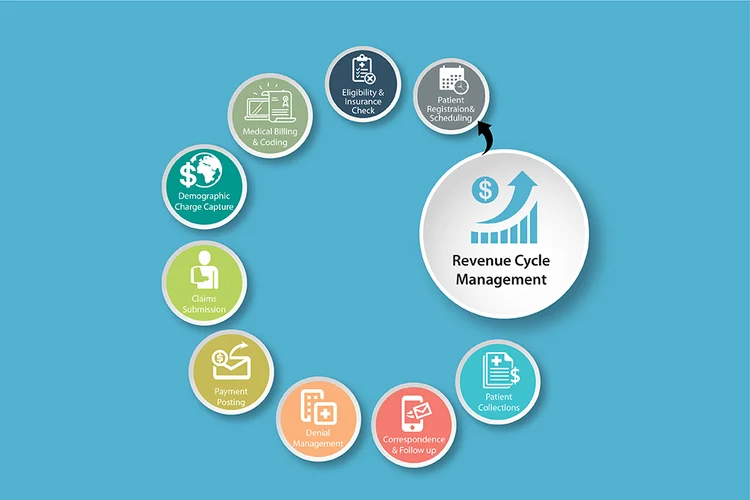
In today’s healthcare landscape, financial sustainability is just as critical as clinical excellence. As healthcare costs rise and administrative burdens increase, the ability to streamline financial operations without compromising patient care has become essential. Enter revenue cycle management AI—a technological leap that’s reshaping how healthcare organizations handle billing, payments, and the entire financial ecosystem surrounding care delivery.
AI isn’t just about automation or replacing human workers. In revenue cycle management (RCM), it’s about enabling faster, smarter, and more accurate processes.
Understanding Revenue Cycle Management
Revenue cycle management encompasses every step taken to track patient care from the moment an appointment is scheduled to the final payment for services rendered. It includes:
- Verifying insurance eligibility
- Capturing and coding charges
- Submitting claims
- Managing denials and appeals
- Collecting payments from insurers and patients
Errors in this process can lead to revenue loss, delayed payments, and increased costs. Traditionally, RCM has been labor-intensive and error-prone—dependent on human entry, repetitive tasks, and complex workflows. That’s where revenue cycle management AI begins to make a measurable difference.
What Is Revenue Cycle Management AI?
At its core, revenue cycle management AI refers to the use of artificial intelligence—specifically machine learning, natural language processing (NLP), and data analytics—to improve each stage of the billing and payment cycle.
These tools learn from historical billing data, identify patterns, and make real-time decisions that help reduce claim denials, flag underpayments, improve coding accuracy, and forecast financial performance. The result? Health systems that can do more with less while improving transparency and compliance.
Where AI Delivers the Most Impact in RCM
1. Automated Eligibility Checks
Before any medical service is delivered, verifying a patient’s insurance eligibility is essential. AI-driven systems can instantly cross-check insurance information, coverage details, and co-pays without human input, minimizing pre-authorization errors and reducing denied claims due to coverage issues.
2. Smarter Medical Coding
Coding is both art and science, and errors can cost organizations dearly. AI tools trained on millions of records can suggest accurate codes based on physician documentation and clinical notes. By using NLP to interpret unstructured text, AI ensures services are appropriately coded and compliant with ever-changing regulations.
3. Claims Scrubbing and Denial Prevention
AI algorithms can “scrub” claims before submission, checking for missing data, incorrect modifiers, or mismatched codes. These systems use historical denial trends to identify likely rejection points and suggest fixes before submission. This significantly reduces the volume of rejected claims and accelerates payment cycles.
4. Denial Management
When claims are denied, time is of the essence. AI in revenue cycle management can quickly analyze why a claim was rejected, group similar denials, and even generate appeal letters using pre-approved templates. This allows billing teams to prioritize their workload and resolve issues more effectively.
5. Payment Reconciliation and Forecasting
AI tools automatically match incoming payments with outstanding claims, even in complex scenarios with partial payments or bundled services. Predictive models can also forecast payment timelines and revenue projections, helping administrators make better financial decisions.
Benefits That Extend Beyond the Bottom Line
While revenue cycle management AI certainly improves financial performance, its ripple effects are felt throughout the organization:
- Increased staff efficiency: By automating repetitive tasks, staff can focus on resolving high-impact issues or improving patient engagement.
- Faster reimbursements: Clean claims get paid more quickly, improving cash flow.
- Improved accuracy: AI reduces human error and ensures compliance with payer policies.
- Better patient experience: AI tools can generate personalized billing communication, offer payment plan suggestions, and answer billing questions through virtual assistants.
These benefits contribute to a healthier bottom line and a better overall patient journey—something every healthcare provider is striving for in a value-based care environment.
Implementation Considerations
Adopting AI in revenue cycle management is not without challenges. Here’s what healthcare leaders should consider:
- Data quality: AI models rely on clean, complete data. Poor data inputs limit effectiveness.
- System integration: AI tools must work with existing electronic health records (EHRs) and billing systems.
- Staff training: Teams need to understand how to work alongside AI—when to trust it, when to review its suggestions, and how to interpret its outputs.
- Compliance and security: All AI solutions must adhere to strict privacy laws like HIPAA and maintain full audit trails for accountability.
A thoughtful, phased implementation can mitigate risks and maximize benefits.
The Future of AI in RCM
As AI continues to evolve, we’ll see more predictive and prescriptive applications in revenue cycle management. Future systems may not only suggest how to handle a claim but recommend workflow changes to avoid similar issues altogether.
We can also expect more integration of AI with patient engagement tools—giving patients real-time visibility into their bills, insurance status, and out-of-pocket costs before they even visit the clinic. This proactive transparency builds trust and can improve both collections and satisfaction.
Final Thoughts
Revenue cycle management AI represents a major step forward in making healthcare finance smarter, leaner, and more responsive. As the pressure to deliver high-quality care while maintaining fiscal responsibility intensifies, AI provides a critical edge.
It’s not about replacing human judgment—it’s about enabling healthcare teams to work more efficiently, respond to problems faster, and focus their efforts where they matter most. With the right strategy, AI is no longer just a tool. It becomes a partner in transforming the financial side of healthcare into something more accurate, more efficient, and more humane.







